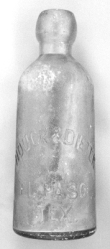 Figure 1 - Houck & Dieter
Hutchinson Bottle
Figure 1 - Houck & Dieter
Hutchinson BottleA New Twist for Uncapping Old Information about Glass Artifacts
by Bill Lockhart
(Originally published in the Jornada Mogollon Archaeology: Collected Papers from the Eleventh Jornada Mogollon Conference. Edited by Patrick H. Beckett, pp. 101-117. Coas Publishing and Research, Las Cruces, NM.)
Abstract
Researchers typically only look for historical information to assess bottles and other glass artifacts that have already been excavated. Global local research, conducted prior to discoveries, can provide a powerful tool for dating and understanding glass artifacts. Examples from the El Paso, Texas, area provide support for local research prior to excavation.
Because glass artifacts were usually common and generally disposable, they are frequently considered to provide some of the best dates for temporal evaluation of historical sites. Until fairly recently, however, historical archaeologists have relied primarily on national product information to identify and date glass containers and other historical artifacts located in local excavations. Although national dating information for glass artifacts produces more concise dating and use information than most other forms of dating historical artifacts, products stored for long periods or those with extended general use spans (e.g., eating utensils, automobile or buggy parts, tools, footwear, etc.) often confound finer dating because of deposition lag (Adams & Gaw 1977; Hill 1982). Such dating also relies on the use of national data which may not be completely applicable to local conditions (e.g., Kendall 1979). Therefore, national data may be somewhat gross in comparison to the finer temporal qualities of local data.
The datability of local glass artifacts becomes more and more refined as twentieth century data become more important. Because of the generally established fifty-year span for the temporal definition of “historical,” even items as recent as 1950 become important in dating historical sites. Increasingly, newer data become important if for no other reason than to assess what is not historical (e.g., the discovery of aluminum pop-tops at specific excavation levels). Several things make more recent glass artifacts easier to date more concisely. First, recent data is more available from manufacturers, bottlers, and local dealers. Second, many manufacturing techniques have changed more rapidly during the twentieth century. Third, many local companies have frequently changed names (often with minor variations) or changed bottling styles. Each change provides a new date range.
In addition, many local bottlers were only in business for a short period of time. Several El Paso soda bottlers were only listed in the city directories for a single year or for a very short time span. Despite this brevity of existence, some of their bottles appear in El Paso excavations and collections.
Although national brands comprise a larger range of variation, local containers often include soda, milk, beer, and drug store bottles. Unless the researcher is fortunate enough to live in an area where local research has already been affected (e.g., Plattsburgh, NY–cf. Pollard 1993), he or she must begin the task of looking up information about each bottle. Normally, an archaeologist researches individual bottles–ones that she or he needs information about in order to complete a current report. Aside from previously published sources (including both professional and collector literature), typical historical sources (city and state directories, newspapers, interviews with living bottlers, etc.) can be used to provide detailed histories of local bottlers but generally yield little information about bottle variation or dating. Researching individual companies is time consuming and leads to broad conclusions about dating that excludes more refined information about variation of bottle types, changes in container morphology, and dating of both bottle and company changes.
Another avenue that is open to researchers–one that is the heart of some controversy–is the use of bottle collections. Although collectors’ literature has been repeatedly cited by archaeologists (e.g., Ferraro & Ferraro 1966; Kendrick 1963;McKearin & McKearin 1941; Munsey 1970; Wilson 1968) and was virtually the only source of information on glass in the 1960s and 1970s, there is resistance among some archaeologists to making use of unpublished collectors’ knowledge. While it is true that collectors do not use scientific methods in their removal of bottles from historical sites and that the illegal removal of artifacts from public land should be discouraged and prosecuted, in reality, the hobby of bottle collecting is here to stay. As archaeologists, we can ignore this resource or make use of it. What collectors possess that is generally unobtainable to archaeologists is a visual display of a broad range of glass containers. Some El Paso collections contain hundreds or even more than 1,000 bottles. This offers a broad range of variation to a careful observer.
The use of collections is not a new idea to prehistoric archaeologists. Type collections of ceramic sherds or local lithic materials are common. So why not extend that idea to historical collections as well. Glass color type collections could facilitate better organization of glass artifacts by color. And local type collections of bottles can expedite the identification of glass containers. In amassing such a type collection of El Paso soda, milk, beer, and drug store bottles and rendering it into manuscript form, I have discovered nuances of identification and dating possibilities heretofore unavailable in dating local (in this case, El Paso) bottles.
Combining historical research (including interviews of living bottlers), archaeological data from local excavations and surveys, and collector information (including collections) has enabled me to produce a study of El Paso soda bottles that includes broad generalizations about trends in the industry and narrow variations in dates and types of bottles (I presented the broad view at the X Jornada Mogollon Convention, October 16-18, 1997–see Lockhart 1999b). I am conducting similar studies to include milk, beer, and drug store bottles of El Paso and soda, milk, and drug store bottles from Alamogordo, Las Cruces, and Deming, New Mexico.
Examples
A Hypothetical Case
The various levels of research an analyst can follow may be exemplified by the Hutchinson-type finish soda bottle used by Houck & Dieter, El Paso’s earliest soda bottler. These bottles had mold lines that terminated just above the shoulder, Hutchinson-style finishes, and embossed (no plate mold) labels in a tombstone shape. The base was embossed H & D, and a manufacturer’s mark of I G Co appeared on the back heel of some bottles. Such bottles are not uncommon in pre-1900 historical excavations in El Paso, and, in our hypothetical case, we will assume that our bottle does not contain the manufacturer’s mark (although I have included information pertinent to the mark for comparative purposes).
 Figure 1 - Houck & Dieter
Hutchinson Bottle
Figure 1 - Houck & Dieter
Hutchinson Bottle
If an investigator uses only national information, the easiest to access, he or she can only address manufacturing style and manufacturer’s marks on these bottles. Hutchinson’s Patent Spring Stopper was patented in April 8, 1879, by W. H. Hutchinson & Son. Finishes of this type were in general use from 1880 to 1905 or later (Paul & Parmalee 1973:12-20). The I G Co mark was used by the Illinois Glass Company of Alton, Illinois, from 1880 to 1900 (Toulouse 1971:264) and by Ihmsen Glass Co., Pittsburgh, Pennsylvania, from 1870-1895, although Toulouse (1971:261-263) suggests that Ihmsen rarely used the mark. Assuming the Illinois Glass Co. was the most likely manufacturer, the manufacturer’s mark data would have been very close to the actual use dates, but a container unmarked by the maker could only be dated (with national data) to the use period of the spring stoppers (1880- 1905+).
The first level of local historical research is generally the city directories. The earliest available El Paso city directory is the 1885 edition. This directory lists Houck & Dieter, so we have a beginning date of at least 1885 for the company. The last listing for the firm under the heading of bottlers is in 1912, but it continues to be listed under liquor dealers until 1918. The researcher now has to make a deduction or seek other sources. If the seeker is astute, he or she may notice that Purity Bottling & Manufacturing Co. also ceased business in 1912, and Empire Bottling Works began operation that year. In fact, Purity merged with the soda division of Houck & Dieter to form Empire Bottling Works. The liquor division remained in business until local Prohibition in Texas closed the company at the beginning of 1919. Our first historical source sets dates of 1885 to 1912 (or 1918), although the end of production of spring stoppers reduces the final use of the bottle to 1905 (or later).
Since El Paso has a reasonably good index for its newspapers (first compiled by members of the Civilian Conservation Corps during the Great Depression), the press is the next logical source. The El Paso Times of January 1, 1882, identified Houck & Dieter as "a branch of A. L. Houck & Co., Santa Fe, New Mexico, the largest and most extensive wholesale beer and soda house in the territory" and credited the opening date of the bottle works at April 1, 1881. John Phillip Dieter managed the El Paso establishment that the Times crowed was "the largest establishment west of Chicago, employing a large number of men." The firm soon expanded, adding a branch in Ciudad Juárez, Mexico, and Dieter became involved in many other El Paso enterprises including Dieter & Sauer, a rival liquor firm, and the El Paso Brewery (Lockhart 1997a:97-99). Incidently, A. L. Houck & Co. was founded in June 1880 and burned to the ground in early 1883. Houck eventually came to work with Dieter in El Paso. Our researcher now has the correct company dates of 1881-1912 and can limit the date of his/her bottle between 1881 and 1905 (or later).
Discussions with bottle collectors, observing their collections, and maintaining a type collection provide the means to fill in the final date reduction. Houck & Dieter used three bottle styles during the 24 years they were in business. The first was the Hutchinson-style spring stopper bottle that our hypothetical investigator is researching, followed by two crown-finish types. Although we have no direct evidence of when Houck & Dieter switched styles, we do
 Figure 2 - H & D -
Second Crown Bottle
Figure 2 - H & D -
Second Crown Bottle Figure 3 - H & D -
First Crown Bottle
Figure 3 - H & D -
First Crown Bottleknow that they were very competitive, and their only real rival in the soda bottling business prior to 1906 was R. F. Johnson & Co. (1892-1898) which was succeeded by Henry Pfaff (1898- 1907) in late 1898. Pfaff became the manager of R. F. Johnson & Co. when Johnson moved to California in 1895 and eventually took over the business (Lockhart 2000). Pfaff upgraded Johnson’s spring stopper bottles to crown closures between 1895 and 1898. Because of the rivalry between the two businesses, it is likely that Houck & Dieter improved their bottles about the same time. Therefore, the final dates for our spring stopper bottle is 1881-ca. 1898 (or earlier).
Short Time Bottlers
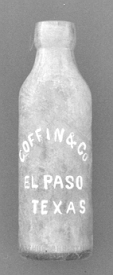 Figure 4 - Coffin & Co. -
Possibly El Paso’s First
Soda Bottle
Figure 4 - Coffin & Co. -
Possibly El Paso’s First
Soda Bottle Figure 5 - G. Edward
Angerstein was only in
business for one year -
1884
Figure 5 - G. Edward
Angerstein was only in
business for one year -
1884
In El Paso, several bottlers were open for just a few years or, in a few cases, only one year. Because this short-term commercial existence was unintended, many of these bottlers began with embossed containers that clearly identified the company. These become very finely datable artifacts to an informed investigator. A total of eight El Paso bottlers were only listed in the city directories for a single year. The El Paso Times only ran a single ad (in a still-existing issue) for Coffin & Co. in 1881, although it is possible that the company existed earlier. Coffin & Co. offered soda bottling kits for preparing soda water at home. The kits contained an embossed bottle. G. Edwin Angerstein only advertised a few months in El Paso papers (1884) and never was listed in a city directory. His bottles still exist. Other single-year bottlers include International Bottling Works (1917), Tickle Beverage & Manufacturing Company (1920), Antonio Patino (1922), El Paso Beverage Co. (1935), T. R. Fye Products Co. (1936), Sun Spot Bottling Company (1948) (absorbed by the Seven-Up Bottling Co.), and Lone Star Sparkling Beverages (1955). While the existence of these companies may have extended beyond the single year that they advertised, it is unlikely that they lasted much longer. Dating of these bottles is therefore quite precise.
Knowing the date when any bottler ceased operations is also valuable (regardless of length of time in business). When using returnable bottles, a sound business does not discard outmoded styles until they have become unuseable. This continued use of outdated styles (part of the deposition lag) creases problems with the end date of most bottle styles. The exception to this practice is when a bottling company terminates its business. At this point, the end date (except for curation by users) becomes absolute. In the example given above, bottles used by Purity Bottling & Manufacturing Co. and the final bottle style used by Houck & Dieter may be
 Figure 6 - Purity
Bottling & Mfg. Co.
Merged with Houck &
Dieter in 1912
Figure 6 - Purity
Bottling & Mfg. Co.
Merged with Houck &
Dieter in 1912 Figure 7 - Hobble-Skirt
Coca-Cola Bottle
Figure 7 - Hobble-Skirt
Coca-Cola Bottleassigned a correct end date of 1912. Similarly, when Henry Pfaff sold his liquor business to Southwest Liquor Co. in 1907, the new company discontinued soft drink manufacture. The final date for Pfaff bottles is definite at 1907.
Most glass artifact analysts who deal with 20th century
bottles are aware of the dating chart for “hobble-skirt” Coca-
Cola bottles presented by Munsey (1970:62-63) using
information provided by the Coca-Cola Company, and a few are
aware of Kendall’s scheme (1979:7) which notes that most
franchises did not adopt the bottles immediately after any of the
parent company’s suggested changes and includes overlaps into
the next style change period. His date-range for the 1915
design, for example, is 1917-1930 where Munsey claims1916-
1924.
![]() Each of the major design changes included a design
variation on the city and state information located on the
bottle’s base. Although these variations fluctuate from area to area, they are
generally consistent within a franchise.
Each of the major design changes included a design
variation on the city and state information located on the
bottle’s base. Although these variations fluctuate from area to area, they are
generally consistent within a franchise.
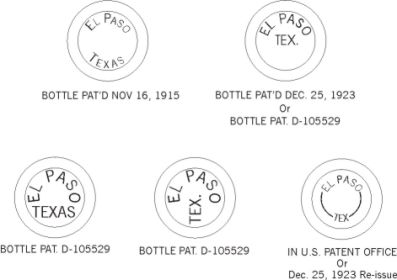 Figure 8 - Changes in Lettering Style on Coca-Cola Bases
Figure 8 - Changes in Lettering Style on Coca-Cola Bases
Pollard (1993:46-47) noted that each Coca-Cola style change also produced a different base embossing or set of embossings that can be used as a dating method. Because many of the glass artifacts excavated by archaeologists are fragmentary, methods of dating bases may be helpful. El Paso hobble-skirt Coke bottle bases also follow a distinct pattern change with each of the parent company’s design changes. Thus, empirical evidence (through maintaining a type collection) provides a way to date base fragments that could otherwise only be dated as being made after 1916! To date, my empirical research suggests that design changes on bases correlate not only with design changes but also with the manufacturer of the bottle. Figure 8 provides type variations in the first four styles of hobble-skirt Coca-Cola bottles in the El Paso area.
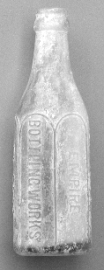 Figure 10 - ...and the
Original Empire Bottling
Works Container
Figure 10 - ...and the
Original Empire Bottling
Works ContainerFort Bliss
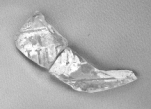 Figure 9 - Two Fragments from the
TRC Mariah Fr. Bliss Excavation...
Figure 9 - Two Fragments from the
TRC Mariah Fr. Bliss Excavation...
TRC Mariah, Inc. conducted a series of excavations on Fort Bliss that included a trash dump thought to be from around the time of Pershing’s expedition against Pancho Villa (based from Fort Bliss). Dating of the dump to support that conclusion became quite important. Several glass fragments contained embossing but were not readily identifiable by normal methods. By use of my type collection and familiarity with other El Paso collections, I was able to identify and date several artifacts that would have otherwise been non- diagnostic.
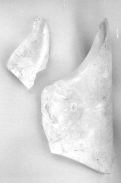 Figure 11 - Two Fragments
marked AW...CO...EXAS...
Figure 11 - Two Fragments
marked AW...CO...EXAS...
An example consisted of two colorless fragments that fit together and were embossed TLIN and EL P separated by an embossed line. Similarly, two fragments, aqua (common green) in color, also fit together and were embossed TTLIN between two embossed lines. Both dyads fit only one type of bottle commonly used in El Paso. The bottles were used by Empire Bottling Works from 1912 to 1924 and were manufactured with both the two-piece, blown-in-mold technique and by machine. A similar bottle style was used by Houck & Dieter, an older bottler that merged with Purity Bottling & Manufacturing Co. to form Empire. The older style, however, did not include the word BOTTLING, portions of which survives on the fragments described above.
Two other fragments from the same excavation were embossed AW and EXAS. along the edge of a plate mold with CO. coming in horizontally. Both fragments come from a machine-made, plate mold bottle used by Woodlawn Bottling Co. from ca. 1915 to ca. 1920. These bottles are known in light blue and aqua (common green) colors.
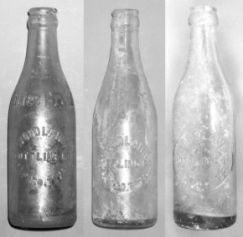 Figure 12 - and the Original Woodlawn Bottles
Figure 12 - and the Original Woodlawn Bottles
Although the specific bottle style can be determined, three different Woodlawn bottles (all dating to the same period) used plate molds of this description. Plate molds on each bottle were embossed WOODLAWN (downward arch) /BOTTLING CO. (horizontal)/EL PASO, TEXAS. (upward arch). None contained manufacturer’s marks or mold designations. The first possibility was embossed ToLtec Brand across the shoulder (with a large capital L); the second was embossed REGISTERED (slight downward arch) across the shoulder; and the last had no shoulder embossing. The size and style of the letters indicate that the fragments in the Fort Bliss collection came from the last (unembossed shoulder) style. The letters “AW” in WOODLAWN in the Toltec Brand are too large and of a different style than those in the target fragments. Likewise, the REGISTERED style has slightly larger letters (1.0 cm. in height) while the unembossed shoulder style has letters 0.7 cm. in height, the same size as those on the target fragments.
San Elizario
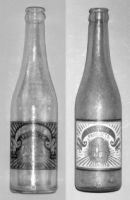 Figure 14 - The Earliest Two
Empire Products Corp. ACL
Bottles
Figure 14 - The Earliest Two
Empire Products Corp. ACL
Bottles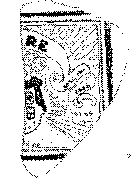 Figure 13 - Drawing of an ACL
Glass Fragment Excavated in San
Elizario, Texas
Figure 13 - Drawing of an ACL
Glass Fragment Excavated in San
Elizario, Texas
An excavation in San Elizario, Texas, produced other examples. One colorless glass fragment that could only be described by the analyst as “from a soda bottle. . . .applied color label [ACL] which postdates 1934" (Vierra et al 1997:9-9) was easily recognizable as a front label from a bottle in use by Empire Products Corp. from about 1936 to about 1945. Such bottles came in both blue and red, and white, blue, and red, and they were the first Applied Color Label (ACL) style container used by the company. The illustrated shard almost certainly originated from the latter style. The fragment contains a 1906 date (Established 1906) which is the date that Purity Bottling & Manufacturing Co., one of the forerunners of the Empire companies, was founded. Lawrence Gardner, the founder of Purity, gradually bought up the stock until he and his wife, Nell, were the sole owners of the company (Lockhart 1997b:123-128).
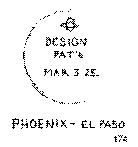 Figure 15 - Drawing of a Base-Body Fragment Excavated in San
Elizario, Texas
Figure 15 - Drawing of a Base-Body Fragment Excavated in San
Elizario, Texas
One base and body fragment was embossed DESIGN PAT’D MAR 25. on the base and marked PHOENIX - EL PASO (Vierra et al 1997:9-17). Unfortunately, the report failed to state either the glass color or whether the PHOENIX - EL PASO designation was ACL or embossed. Table 9.19 (following page 9-17) identified the fragment as “Coca-Cola, Phoenix and El Paso.” This can only be one of two bottle types from two different time periods. If the report had stated whether the lettering was embossed or ACL, I could have specified a date. Even though it did not specify glass color, I can identify the drink.
Only one El Paso soda company had plants in both El Paso and Phoenix–but that one had plants in both cities during two different time periods. Joseph S. Pittman started the Nehi Bottling Co. in Phoenix, Arizona, in 1929 and opened a branch in El Paso two years later (EPCD 1931; Phoenix City Directories 1929-1930). The company sold Nehi flavors in embossed bottles (the style is called “silk stocking” by collectors) that were identified as PHOENIX - EL PASO (or EL PASO - PHOENIX) from 1929 until Winfield F. Ritter bought the El Paso plant for his son, Robert, in 1942. Robert was joined in the business by his brother, William, shortly thereafter. The company name had been changed to Nehi-Royal Crown Bottling Co. in 1941, and the brothers expanded their holdings to include the Phoenix plant in 1947 (Ritter Interview). By this time, bottles bore ACL labels that included both EL PASO - PHOENIX, EL PASO, and PHOENIX designations (along with possibly PHOENIX - EL PASO, although I have never seen any of these). Although William bought out Robert’s share of the Phoenix plant in 1950 (Robert had bought William’s share of the El Paso plant a year earlier), the brothers may have continued to use bottles with both cities on the label.
 Figure 17 - Royal
Crown Cola
Bottle
Figure 17 - Royal
Crown Cola
Bottle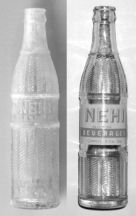 Figure 16 - Nehi Bottles
Figure 16 - Nehi Bottles
The base embossment, DESIGN PAT’D MAR 25, referred to the patent of the silk stocking design used on Nehi bottles, and the designation remained on both embossed and ACL versions of the bottles. The colorless, embossed Nehi bottles were used from 1931 to around 1944 even though the Phoenix plant was no longer part of the El Paso franchise. Colorless Nehi bottles in red and yellow ACL were labeled with PHOENIX - EL PASO, EL PASO - PHOENIX, EL PASO, TEXAS, or (probably) PHOENIX, ARIZONA. The style was in use from about 1944 until 1956. Even though the labeling style (embossed or ACL) was not mentioned in the report, I can still identify the container as definitely being the Nehi bottle (by basal patent information) and as probably being the embossed bottle rather than ACL. The embossed container showed the company information approximately 5 cm. above the resting point of the base; the ACL bottle’s information was more than twice that high. Although far from conclusive, the probability is strongly in favor of the shorter fragment’s existence.
In addition, the light green (red and yellow ACL) Royal Crown bottle contained the variations of the Phoenix and El Paso designations and featured four yellow pyramids on the front and a copyright date of 1936. The style was used until 1953, and the next style (similar but without the pyramids) featured only El Paso (or Phoenix) as place designations.
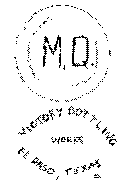 Figure 18 - Drawing of
Embossing from a Bottle
Excavated in San Elizario,
Texas
Figure 18 - Drawing of
Embossing from a Bottle
Excavated in San Elizario,
Texas Figure 19 - The
First of Three
Bottles from
Victory Bottling
Works
Figure 19 - The
First of Three
Bottles from
Victory Bottling
Works
Two aqua (common green) bottles found at San Elizario were embossed VICTORY BOTTLING (downward arch)/WORKS (horizontal)/EL PASO, TEXAS (upward arch) with M. Q. on the base. Victory was open from 1923 to 1931 but changed owners from Mauro Quevedo (the M. Q. on the base) to Alejandro Marquez (with bases marked A. M.) in 1927 (EPCD 1923-1931). Bottles marked M. Q., therefore, date from 1923 to 1927. However, this first bottle style was replaced by a fancier “proprietary” style before Marquez took over, so the first style was probably only in use during the first two years or so. These were identified in the report as “bottled in El Paso. . . .not known if the [bottler is] still in operation or, if not, when they closed. Local city bottling companies were in great abundance during the late 1910s and 1920s” (Vierra et al 1997:9-27).
Another aqua bottle was embossed LONE STAR BOTTLING WORKS/EL PASO, TEXAS with J. U. on the base (Vierra et al 1997:9-27) and was identified in the same way as the Victory bottles (above). The initials stood for Jose Urrutia, the owner of Lone Star from its inception in
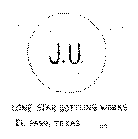 Figure 20 - Drawing of
Embossing from a Bottle
Excavated in San Elizario, Texas
Figure 20 - Drawing of
Embossing from a Bottle
Excavated in San Elizario, Texas Figure 21 -
Container from
Lone Star
Bottling Works
Figure 21 -
Container from
Lone Star
Bottling Works1918 until it ceased advertising in 1934. Urrutia also sold beer in 1918, but State (then Federal) Prohibition soon forced him to concentrate on soft drinks. He also offered "Dressed rabbits delivered" in 1920 and 1921 and was helped in the bottling and rabbit business by his two sons. The family expanded the business and renamed the company Lone Star Bottling & Fuel Co. in 1930, but the Great Depression caught up with them, and they closed the business in 1935 (EPCD 1918- 1935). This bottle was also only identified by the quotation above.
It is important to understand that I am not trying to find fault with the UNM draft report. These researchers are merely following the prescribed methodology for analyzing glass artifacts, especially ones from the period following the19th century (they also made changes using my suggestions in their final report). I am using their draft report to show how much a new method can improve the discipline of historical archaeology as a whole.
Details from Interviews
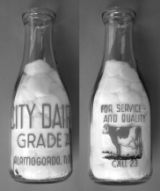 Figure 22 - The 1946 City Dairy Milk
Bottle from Alamogordo, NM
Figure 22 - The 1946 City Dairy Milk
Bottle from Alamogordo, NM
Interviews with bottlers can also be informative. Some, of course, are more helpful than
others, but many people have a store of interesting anecdotes as well as practical information
unavailable from other sources. When interviewing Willie McMurry in
Alamogordo, I learned that his business, City Dairy, bought one half-carload of pyroglazed
![]() quart bottles in 1946 as an experiment. The
bottles are unusual in that they utilized two colors of enamel–red and
green. Most pyroglazed bottles were monochromatic. The
polychrome bottles proved too expensive, however, and the
experiment was not repeated until the 1960s. With the exception of
the 1946 bottles and square (cross-section) creamers with green
pyroglazing in the 1950s, the dairy’s glass containers were unmarked
until the company adopted red and white, rectangular (cross-section)
half-gallon bottles in 1962 (McMurry interview). Although some of
this information is too recent to be of use in current archaeology, it
may be helpful in the future.
quart bottles in 1946 as an experiment. The
bottles are unusual in that they utilized two colors of enamel–red and
green. Most pyroglazed bottles were monochromatic. The
polychrome bottles proved too expensive, however, and the
experiment was not repeated until the 1960s. With the exception of
the 1946 bottles and square (cross-section) creamers with green
pyroglazing in the 1950s, the dairy’s glass containers were unmarked
until the company adopted red and white, rectangular (cross-section)
half-gallon bottles in 1962 (McMurry interview). Although some of
this information is too recent to be of use in current archaeology, it
may be helpful in the future.
Alkividias (Alkie) Nicholson was 86 when I interviewed him and was still as sharp as a freshly-honed razor. When I was able to use other sources to check dates that he provided, he was always right on target. His father opened Nicholson Bottling Works in 1925, and the family business continued until 1979–long after all other family-run soda bottlers in El Paso had fallen to the corporate-owned giants or adopted national franchises.
Alkie’s salary was $1 per day in the 1920s. For that money, he worked from 4:00AM until late in the night. Even in the 1920s, Nicholson filtered the city water to remove chlorine and impurities. He sold sodas at 60¢ per case, and the stores retailed individual bottles for 5¢–a 100% markup. For a while, he bought bottles in Mexico. Although the containers were cheaper, so was the quality–the bottles lasted a much shorter time than those purchased in the US, so the company returned to the use of containers from Liberty Glass Co., Sapulpa, Oklahoma. During the Bracero program of the 1940s, Mexican laborers were encouraged to work in the US, and many farmers in El Paso’s Lower Valley hired large numbers to work on their farms. One of the larger farms bought 300-400 cases of Nicholson sodas a day and provided them to their workers (Nicholson Interviews).
I was fortunate to interview Tom Lucky, a retired manager from Magnolia Coca-Cola Bottling Co. in El Paso (as well as one-time manager of the Coca-Cola Co. in Alamogordo, New Mexico), just a few months before his death (Lucky Interview). He told me about Milda Smith’s sales meetings. Milda became manager of Magnolia upon the death of her husband, Hope Smith, Magnolia’s founder. She would become so excited after sales meetings that she would "drive ninety miles an hour" while talking to her terrified executives. The officials became so alarmed that there was practically a stampede at the end of meetings to beat Mrs. Smith to the steering wheel.
Lucky also described the founding of the Alamogordo Coca-Cola plant, a job he personally supervised. He included details that would have been unavailable from other sources, such as why the steps to the second floor of the 1130 New York Ave. building had such low risers. They were specifically built to accommodate the then infirm, Hope Smith, founder of Magnolia Coca-Cola Bottling Co. of El Paso (1908-present) and the guiding influence in the formation of the Alamogordo plant. He also disclosed that at one time, during the 1950s, Alamogordo had more vending machines per 1,000 people than any other community in the United States. Since the plant only bottled sodas every other day, he hired firemen from Holloman Air Force Base who worked a similar shift.
He found Alamogordo in the 1950s to be clannish and discovered it was difficult to get close to the townspeople. A great opportunity arose when he joined the Rotary Club and became a member of the committee to erect the town Christmas tree on the courthouse lawn. When decoration time came, only two people showed up to decorate the tree, so Lucky dismissed the six-man bottling crew from their tasks at the Coke plant to help with the decoration. That "cleared the way into the hearts of the [local] people," and from that point on he was one of their own. Lucky enjoyed the rest of his stay in Alamogordo and learned to love the people there (Lucky interview, also cf. Lockhart 1998).
Although anecdotes are valuable on their own, many of these stories provide historical information about the day to day operations of these plants. Some (e.g., the McMurry interview) also provide insights into dating information that is otherwise unavailable. Finally, they contribute a sense of the motivation behind some of the decisions made by the various bottlers–something unusual in the typical printed record.
Newspaper Surprises
Occasionally, searches through newspapers for advertisements can be enlightening. Although collectors and archaeologists had previously assumed that the six-panel, embossed
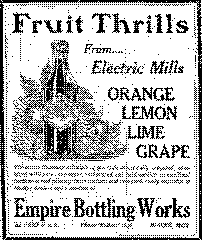 Figure 23 - Empire Ad from the July 3, 1920
Edition of the El Paso Herald
Figure 23 - Empire Ad from the July 3, 1920
Edition of the El Paso Heraldbottle used by Empire Bottling Works from 1912 to 1924 (See Figure 10) was labeled only with the embossing (which covered the entire bottle), newspaper ads in the July 1920 editions of the El Paso Herald depicted the same bottle with paper labels superimposed on the embossing. Because of the ads, we now know that Empire’s brand was called “Fruit Thrills” (with individual flavors known as Grape Thrills, Orange Thrills, etc.). The paper labels were probably not used on the earlier bottles and may only have appeared in 1920.
An equally unusual find was a bitters that was bottled in Alamogordo. An advertisement in the Sacramento Chief of November 19, 1899, offered Sacramento Bitters “prepared by Aragon Bros. Drug Co., Alamogordo, New Mexico.” The ad called the bitters “A Positive Cure for all Diseases of a Bilious Origin.”
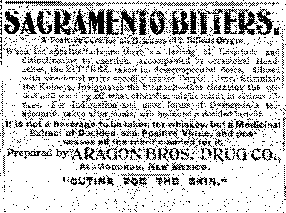 Figure 24 - Sacramento Bitters Ad from the Sacramento Chief,
November 9, 1899
Figure 24 - Sacramento Bitters Ad from the Sacramento Chief,
November 9, 1899
Sacramento Bitters bottles probably only contained paper labels and are thus not generally expected to appear in the archaeological record, but we now have a rough date (1899) if any should appear in excavations. The ad was not repeated in later years. A search of bitters literature (Bartholomew 1970; Ring 1971; Watson 1965; Wichmann 1999; Wilson 1969) yielded no reference to a Sacramento Bitters.
Conclusion
There is a need for local research in all areas of the country and in various sub-disciplines
(including other areas of material culture as well as bottles). The kind of concentrated research
that goes into compiling a complete local history of a genera of bottles (e.g., soda, milk, beer, drug
store) brings to light a great deal of dating and historical information that is difficult to accumulate
when researching bottles (or other artifacts) individually. Pollard (1993) set a good example with
his study of embossed bottles (including beer, soda, milk, and drug store containers) in
Plattsburgh, New York.
![]() Until more of our colleagues follow his example, we will continue to be
dependent on collectors’ literature and studies of individual bottles and companies.
Until more of our colleagues follow his example, we will continue to be
dependent on collectors’ literature and studies of individual bottles and companies.
[In my personal attempt to fill local needs, I have written histories of soda bottlers and dairies of Alamogordo (Lockhart 1998; 1999a), an unpublished manuscript (currently ca. 560 pages) on El Paso soda bottlers and their bottles, and various articles on El Paso bottlers in Password, the journal of the El Paso County Historical Society (e.g., Lockhart 1997a; 1997b). In addition, I have been gathering data on dairies (and milk bottles), drug store bottles, and breweries (beer bottles) in El Paso as well as bottles and bottlers in Las Cruces and Deming.]
Acknowledgements
Although individual photos are not specifically acknowledged, the photos in Figures 2 and 19 were taken by David Cole of Bangs, Texas, and come from his collection. All other photos are my own, taken of various collections. Much gratitude to the following collectors for allowing me to photograph their collections and use some of those photos in this work: Rich Chavez (El Paso, Texas); David Cole (Bangs, Texas); Becky Garrett Collection (El Paso Museum of History); Mike Morrison (Las Cruces, New Mexico); Viola Salas (Alamogordo, New Mexico); Robert Sproull, D. D. S. (El Paso, Texas); and Willie Terrazas (El Paso, Texas). Thanks also to Richard Holmes, Martha Yduarte, and Mark Sechrist of TRC-Mariah (El Paso, Texas) and to Richard Chapman of the Office of Contract Archaeology (University of New Mexico, Albuquerque, New Mexico) for providing examples for me to work with. And my final bouquet of gratitude goes to my wife, Wanda Wakkinen, for proofreading and listening to endless speculation.
Bibliography
Adams, William H. and Linda P. Gaw
1977 "A Model for Determining Time Lag of Ceramic Artifacts" Northwest Anthropological Research Notes 11(2):218-231.
Bartholomew, Ed
1970 1001 Bitters Bottles. Bartholomew House, Fort Davis, Texas.
EPCD - El Paso City Directories
Ferraro, Pat and Bob
1966 A Bottle Collector's Book. Western Printing & Publishing Co., Sparks, Nev.
Hill, Sarah H.
1982 "An Examination of Manufacture-Deposition Lag for Glass Bottles from Late Historic Sites." In Archaeology of Urban America: The Search for Pattern and Progress, pp. 291-327. Edited by Roy S. Dickens. Academic Press, New York.
Kendall, William N. W.
1979 "Coca-Cola Bottle Collecting, Phase III." Old Bottle Magazine 12(5):13-15.
Kendrick, Grace
1963 The Antique Bottle Collector. Old Time Bottle Publishing Co., Salem, Oregon.
Lockhart, Bill
-1997a "The Houck & Dieter/Empire Bottling Works: El Paso's Most Successful Non-Franchise Soft Drink Bottlers," Part I. Password 42(2):93-101.
-1997b "The Houck & Dieter/Empire Bottling Works: El Paso's Most Successful Non-Franchise Soft Drink Bottlers," Part II. Password 42(3):123-134.
-1998 “From Weigele’s Pop to Coca-Cola: The Soda Botters of Alamogordo, New Mexico and Their Bottles.” The Pioneer 1(3, 4):1-45.
-1999a “From Barrett’s Jersey Dairy to City Dairy: Otero County Dairies, 1889 to 1977.” Pioneer 2(3):1-22.
-1999b “Deposition Lag in Returnable Soda Bottles and Bottling Trends in El Paso, Texas.” In Archaeology of the Jornada Mogollon: Prodeedings from the 10th Jornada Mogollon Conference, pp. 157-169. Edited by Michael Stowe and Mark Slaughter. Geo-Marine, Inc., El Paso, Texas.
-2000 “Early El Paso Bottlers: G. Edwin Angerstein, Coffin & Co., R. F. Johnson, Henry Pfaff, and Southwestern Liquor Co.” Password (in press).
Lucky, Thomas C., Personal Interview March 7, 1996.
McKearin, Helen & George
1941 American Glass. Crown Publishers, New York.
McMurry, W. J. “Willie,” Personal Interview, March 20 & 27, 1998.
Munsey, Cecil
-1970 The Illustrated Guide to Collecting Bottles. Hawthorn Books, New York.
-1972 The Illustrated Guide to the Collectibles of Coca-Cola. Hawthorn Books, New York.
Nicholson, Alkividias (Alkie), Series of Personal Interviews in November/December 1995.
Paul, John R. and Paul W. Parmalee
1973 Soft Drink Bottling: A History with Special Reference to Illinois. Illinois State Museum Society, Springfield, Ill.
Phoenix, Arizona City Directories
Pollard, Gordon
1993 Bottles and Business in Plattsburgh, New York: 100 Years of Embossed Bottles as Historical Artifacts. Clinton County Historical Association, Plattsburgh.
Ring, Carlyn
1980 For Bitters Only. Nimrod Press, Boston. (+1984 & 1988 updates)
Ritter, Robert R., Personal Interview, February 22, 1996.
Vierra, Bradley J., June-el Piper, and Richard C. Chapman
1997 A Presidio Community on the Rio Grande: Phase III Testing and Historical Research at San Elizario, Texas. Vol. I. OCA/UNM Report No. 185-545. Office of Contract Archaeology, University of New Mexico, Albuquerque. [Draft]
Watson, Richard
1965 Bitters Bottles. Thomas Nelson & Sons, n.p.
Wichmann, Jeff
1999 Best of the West: Antique Western Bitters Bottles. Pacific Glass Books, Sacramento, California.
Wilson, Bill and Betty
-1968 Spirits Bottles of the Old West. Antique & Hobby Publishing Co., Amador City, Cal.
-1969 Western Bitters. Old Time Bottle Publishing Co., Salem, Oregon.